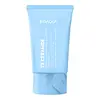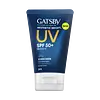What's inside
What's inside
 Key Ingredients
Key Ingredients

 Benefits
Benefits

 Concerns
Concerns

 Ingredients Side-by-side
Ingredients Side-by-side

Water
Skin ConditioningOctocrylene
UV AbsorberHomosalate
Skin ConditioningGlycerin
HumectantEthylhexyl Salicylate
UV AbsorberButyl Methoxydibenzoylmethane
UV AbsorberPropylene Glycol
HumectantEthylhexyl Palmitate
EmollientPolysorbate 60
EmulsifyingSorbitan Stearate
EmulsifyingBis-Ethylhexyloxyphenol Methoxyphenyl Triazine
Skin ConditioningDimethicone
EmollientGlyceryl Stearate
EmollientStearyl Alcohol
EmollientCarbomer
Emulsion StabilisingTriethanolamine
BufferingHydroxypropyl Tetrahydropyrantriol
Skin ConditioningMenthyl Lactate
MaskingPhenoxyethanol
PreservativeAllantoin
Skin ConditioningCetyl Alcohol
EmollientXanthan Gum
EmulsifyingEthylhexylglycerin
Skin ConditioningButylene Glycol
HumectantChrysanthemum Indicum Extract
AntioxidantMentha Arvensis Leaf Extract
MaskingPortulaca Oleracea Extract
Skin ConditioningPelargonium Graveolens Extract
MaskingCeramide Ns
Skin ConditioningCeramide NP
Skin ConditioningCeramide Ng
Skin ConditioningCeramide Eos
Skin ConditioningCeramide EOP
Skin ConditioningCeramide As
Skin ConditioningCeramide AP
Skin ConditioningResveratrol
AntioxidantBisabolol
MaskingTremella Fuciformis Sporocarp Extract
AntioxidantAloe Barbadensis Leaf Extract
EmollientMyristyl Alcohol
EmollientArachidyl Alcohol
EmollientCitrus Reticulata Fruit Extract
Skin ProtectingCitrus Medica Limonum Peel Extract
EmollientSophora Angustifolia Root Extract
Skin ConditioningWater, Octocrylene, Homosalate, Glycerin, Ethylhexyl Salicylate, Butyl Methoxydibenzoylmethane, Propylene Glycol, Ethylhexyl Palmitate, Polysorbate 60, Sorbitan Stearate, Bis-Ethylhexyloxyphenol Methoxyphenyl Triazine, Dimethicone, Glyceryl Stearate, Stearyl Alcohol, Carbomer, Triethanolamine, Hydroxypropyl Tetrahydropyrantriol, Menthyl Lactate, Phenoxyethanol, Allantoin, Cetyl Alcohol, Xanthan Gum, Ethylhexylglycerin, Butylene Glycol, Chrysanthemum Indicum Extract, Mentha Arvensis Leaf Extract, Portulaca Oleracea Extract, Pelargonium Graveolens Extract, Ceramide Ns, Ceramide NP, Ceramide Ng, Ceramide Eos, Ceramide EOP, Ceramide As, Ceramide AP, Resveratrol, Bisabolol, Tremella Fuciformis Sporocarp Extract, Aloe Barbadensis Leaf Extract, Myristyl Alcohol, Arachidyl Alcohol, Citrus Reticulata Fruit Extract, Citrus Medica Limonum Peel Extract, Sophora Angustifolia Root Extract
Water
Skin ConditioningButylene Glycol
HumectantEthylhexyl Methoxycinnamate
UV AbsorberDiethylamino Hydroxybenzoyl Hexyl Benzoate
UV FilterSilica
AbrasiveEthylhexyl Palmitate
EmollientPentylene Glycol
Skin ConditioningPolyglyceryl-10 Myristate
Skin ConditioningPhenoxyethanol
PreservativeCaprylyl Glycol
EmollientCarbomer
Emulsion StabilisingParfum
MaskingPotassium Hydroxide
BufferingHydrolyzed Collagen
EmollientXanthan Gum
EmulsifyingTocopherol
AntioxidantMorus Alba Leaf Extract
Skin ConditioningNiacinamide
SmoothingBHT
AntioxidantCamellia Sinensis Leaf Extract
AntimicrobialWater, Butylene Glycol, Ethylhexyl Methoxycinnamate, Diethylamino Hydroxybenzoyl Hexyl Benzoate, Silica, Ethylhexyl Palmitate, Pentylene Glycol, Polyglyceryl-10 Myristate, Phenoxyethanol, Caprylyl Glycol, Carbomer, Parfum, Potassium Hydroxide, Hydrolyzed Collagen, Xanthan Gum, Tocopherol, Morus Alba Leaf Extract, Niacinamide, BHT, Camellia Sinensis Leaf Extract
Ingredients Explained
These ingredients are found in both products.
Ingredients higher up in an ingredient list are typically present in a larger amount.
Butylene Glycol (or BG) is used within cosmetic products for a few different reasons:
Overall, Butylene Glycol is a safe and well-rounded ingredient that works well with other ingredients.
Though this ingredient works well with most skin types, some people with sensitive skin may experience a reaction such as allergic rashes, closed comedones, or itchiness.
Learn more about Butylene GlycolCarbomer is a polymer of acrylic acid. Its main role is to create a gel consistency.
A high amount of carbomer can cause pilling or balling up of products. Don't worry, most products contain 1% or less of carbomer.
Ethylhexyl Palmitate, also known as octyl palmitate, is created from 2-ethylhexyl alcohol and palmitic acid. It is a fatty acid ester.
The fatty acid content of Ethylhexyl Palmitate makes it an emollient. Emollients help soften and hydrate your skin by trapping moisture within.
Ethylhexyl Palmitate is also used to help improve the texture of cosmetics. It helps other ingredient dissolve in products and help disperse ingredients more evenly.
You'll likely find this ingredient in sunscreen, as it is often used to mix UV-blocking ingredients such as avobenzone and ethylhexyl triazone.
It can also help stabilize the fragrances in a product as a fragrance fixative.
Ethylhexyl Palmitate can be used to substitute mineral oil.
Due to its high fatty acid content, it may not be fungal-acne safe.
Learn more about Ethylhexyl PalmitatePhenoxyethanol is a preservative that has germicide, antimicrobial, and aromatic properties. Studies show that phenoxyethanol can prevent microbial growth. By itself, it has a scent that is similar to that of a rose.
It's often used in formulations along with Caprylyl Glycol to preserve the shelf life of products.
Water. It's the most common cosmetic ingredient of all. You'll usually see it at the top of ingredient lists, meaning that it makes up the largest part of the product.
So why is it so popular? Water most often acts as a solvent - this means that it helps dissolve other ingredients into the formulation.
You'll also recognize water as that liquid we all need to stay alive. If you see this, drink a glass of water. Stay hydrated!
Learn more about WaterXanthan gum is used as a stabilizer and thickener within cosmetic products. It helps give products a sticky, thick feeling - preventing them from being too runny.
On the technical side of things, xanthan gum is a polysaccharide - a combination consisting of multiple sugar molecules bonded together.
Xanthan gum is a pretty common and great ingredient. It is a natural, non-toxic, non-irritating ingredient that is also commonly used in food products.
Learn more about Xanthan Gum